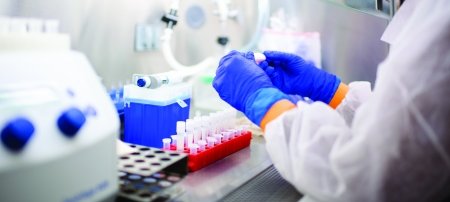Michigan Tech's human-centered research improves lives. Here's how.
From enhanced cancer detection to the power sources that supply surgical room equipment, Michigan Technological University is a health-care innovator that prepares people and creates technologies to improve lives and strengthen communities.
Self-sterilizing wound dressings. Bone-regeneration systems. Heart muscle cells grown faster and stronger, with less chance of rejection. Researchers, inventors, analysts, and investigators pioneer H-STEM, the health- and human-centered aspects of science, technology, engineering, and math. The research is translational, interdisciplinary, and increasingly convergent.
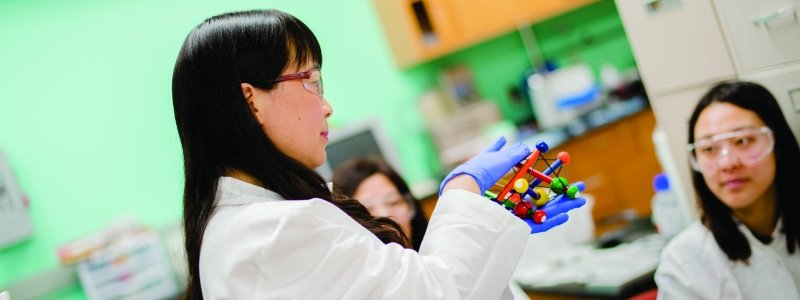
The Tech Side of Medicine
From measuring vitamins in tears to purifying viruses for safer vaccine production, the Tech side of medicine is translational bench-to-bedside research, with the deliberate aim to improve health outcomes. It encompasses biomedical, chemical, mechanical, electrical, and computer engineering. It incorporates materials science and engineering, biology, chemistry, cognitive and learning sciences, computer science, and kinesiology and integrative physiology.
Convergence expands discovery—think of it as cross-, multi-, inter-disciplinary collaboration to the Nth power. As the National Research Council Project Convergence: Facilitating Transdisciplinary Integration of Life Sciences, Physical Sciences, Engineering, and Beyond, notes, convergence creates an environment for experts in one field to become fluent in others, freeing researchers to think in new ways, and create new frameworks, solutions, and disciplines.
The Human Effect
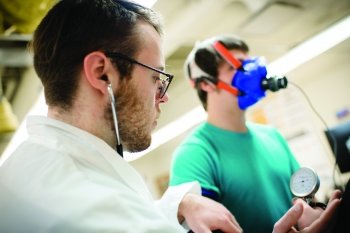
Going to the doctor, consulting a surgeon, working with a physical therapist—familiar routines for many, especially as we age. H-STEM work at Michigan Tech encompasses the health needs of people throughout their lives, from wellness checks to diagnoses, to recovery after complex medical procedures.
Researchers on the prevention forefront study the effectiveness of skin creams, standing desks, blueberries in diet, and strength training for all ages and abilities. Other studies quantify the effects of meditation, how alcohol affects sleep, and the cardiovascular ramifications of sleep patterns in postmenopausal women.
Outgoing Michigan Tech President Glenn Mroz, who sees Michigan Tech's work in the health field as vital to the University's mission, explains how technology drives care:
"We're thankful for what skilled doctors can do for us with the tools that they have—the procedures, prescriptions, and equipment that they use to keep us healthy," he says. "But where do these tools come from? And who makes them? They're made using other tools—science, technology, engineering, mathematics, and management—by people inspired to make a difference and apply what they know to one of the most challenging issues of our time."
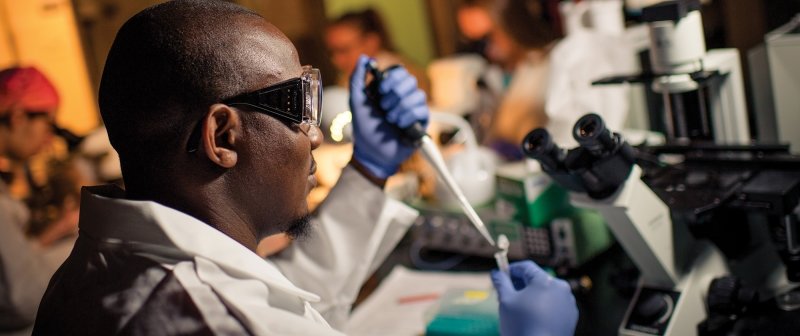
Examples of inspired innovation abound, including research that results in more accurate tests and treatments. Cases in point: a fluorescent probe that detects cancer type as well as malignancy, and the fluorescent dye that marks the line between cancer cells and healthy tissue—a beacon for surgeons who seek to take all of what needs to be removed but no more.
Researchers build scaffolds to help nerves reconnect, create smart implants, develop new adhesives for surgery, new materials for stents, and smart artificial limbs and joints. They create an environment where your own heart cells, used to repair heart muscle damage, can grow to fully functional maturity.
Medical informatics and statistical research are also powerful tools for healthy communities.
"Imagine using a supercomputer and vast data sets to help identify those of us at risk for hypertension, type II diabetes, and ALS so that preventative measures can be taken before the illness begins to take hold," says Mroz. "A math professor and her students are doing that work at Michigan Tech."
"It takes passion, tenacity, undaunted intelligence, work ethic—students learn it and inspire it in one another. That's why Michigan Tech is the top public university in the United States for the number of students who become inventors per 1,000 students."
H-STEM work involves Huskies at every stage of educational and career development. Huskies teach pre-college summer youth program participants the basics of designing and assembling simple heart monitors and pursue dynamic collaborations across campus and beyond Innovation Shore with other institutions of higher learning and industry.
Healthy Education, Economic, and Industry Outcomes
Michigan Tech's reputation for applied innovation draws companies including Plexus, Delphinus Medical Technologies, Phillips-Medisize, MPI Research, RTI Surgical, Teleflex Medical, Boston Scientific, and Medtronic to campus. Leaders in health care technology hire Michigan Tech students—and sponsor research.
A walk down the aisles of Michigan Tech's annual Design Expo, showcasing undergraduate Enterprise teams and Senior Design projects, reveals how the human-health-related side of STEM is infused into the campus life cycle. Student teams are designing, building, and testing safer ways to transport vaccines. Creating low-cost ventilators. Conducting gait analysis to help reduce the amount of time it takes for knee and hip surgery patients to recover. Conceptualizing dynamic heart models.
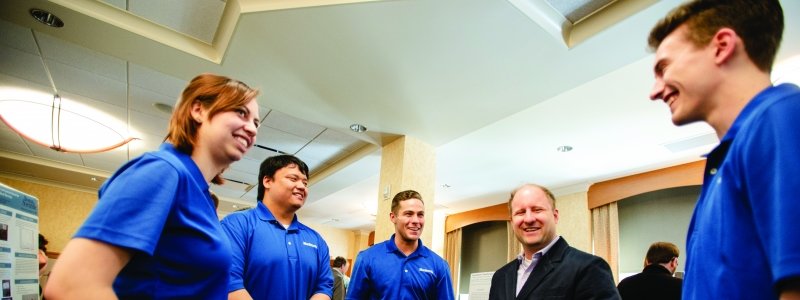
The latter is one of two Senior Design projects Boston Scientific is sponsoring. The company partners with numerous universities including Michigan Tech. Kate Taylor, Boston Scientific Global Innovation Program Manager, is the university portal; she was keynote speaker at the 2018 Michigan Tech Medical Devices Day during Medical Careers Week. Jon Stinson, Boston Scientific's research and development analytical director for Global Technologies and Services Organization, and a 1982 Michigan Tech metallurgical engineering grad, was on campus for the Biomedical Engineering (BME) Professional Advisory Board Meeting and Design Expo 2018.
"One of our company's core values is meaningful innovation," says Stinson. "We reach beyond internally ingrained experiences for unbiased perspectives and constraints, to get a more open-minded approach to solving new problems and needs for advanced therapies and devices. We come with what-ifs and how-abouts—we don't know if they have solutions or value yet—and we can hand that to faculty and students with high levels of technical competency and see where it leads."
"Michigan Tech is known for preparing practical, applied-engineering-minded undergrads. And it's a great sandbox for exploring ideas."
Global medical device manufacturer Medtronic partnered with a Senior Design team working on a multi-coil passive recharging prototype to make the charging process easier for people who use a spinal cord stimulation implant to alleviate suffering from chronic intractable back pain.
"This is our fourth project with the Michigan Tech Biomedical Department. We came back because of the fantastic teamwork of the students and the department," says Carl Wahlstrand, engineering program director for patient care devices in Medtronic's Restorative Therapies Group. Wahlstrand and Mark Gryzwa, senior program director in the Restorative Therapies Group, are both Michigan Tech electrical engineering graduates (2001 and 1989, respectively) and among several alumni working with the company in its mission to apply biomedical engineering to research, design, manufacture, and sell instruments and appliances to alleviate pain, restore health, and extend life.
"We find Tech students to be very practical, hands-on, and willing to dig in."
A coil array, rather than a single coil, could allow users to recharge their implants one to three centimeters beneath the skin without repeated adjustments and make it easier to incorporate the process seamlessly into their daily routines. It's just one example of how technology is driving the ability to take better care of ourselves and others, and an important one, Wahlstrand notes. More than 25 million Americans suffer from daily chronic pain, according to the National Institutes of Health. It's a major player in health-care spending, and the price paid for opioid addiction continues to mount in lives and dollars. Drug overdose is now the leading cause of death for Americans under age 50, according to the US Center for Disease Control.
A Healthy Future for Health Research
Michigan Tech has more than tripled human health research funding from the National Institutes of Health over the past four years. In 2008, about 22 faculty members were involved in health research and education; today, more than 70 work in this arena.
The American Heart and Lung Associations, National Science Foundation, Gerber Foundation, and Portage Health Foundation, among others, also support human-centered research at Michigan Tech.
"Life sciences is the greatest economic growth sector in Michigan. In 2017, 42 percent of venture capital invested in the state was in health care and life sciences business development: 37 percent in devices, 19 percent in biotechnology and biochemistry, and 12 percent in diagnostics."
"Faculty, staff, and students have been increasingly successful in attracting external funding for their health-related research. The increase has resulted in enrollment growth for degree programs that apply engineering, science, technology, and mathematics to questions related to health and human-centered engineering," says Mroz. "And while this is great news, we're in danger of growing past our physical capacity."
The answer, many believe, is an H-STEM complex that will house an array of human-centered research, development and education programs, from therapeutic devices, sensors, and instruments to preventative strategies.
Michigan Technological University is an R1 public research university founded in 1885 in Houghton, and is home to nearly 7,500 students from more than 60 countries around the world. Consistently ranked among the best universities in the country for return on investment, Michigan's flagship technological university offers more than 185 undergraduate and graduate degree programs in science and technology, engineering, computing, forestry, business, health professions, humanities, mathematics, social sciences, and the arts. The rural campus is situated just miles from Lake Superior in Michigan's Upper Peninsula, offering year-round opportunities for outdoor adventure.

